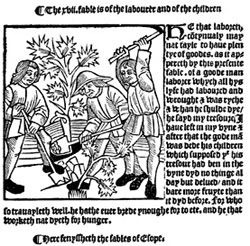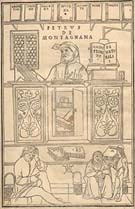
From William Caxton's translation into English of Aesop's Fables (London: Richard Pynson, 1500-01), shelfmark: IB.55523 © The British Library Board.
![]()
Introduction
The British Library's collection of incunabula (15th-century books produced with moveable type) is unrivalled in size and scope: some 12,500 incunabula representing about 10,390 editions, out of an estimated total of surviving 28,000 editions.
The invention of printing with moveable type saw the beginning of a mass production and a Europe-wide mass distribution of texts and associated images.
This created radically new conditions for the diffusion of ideas, information, and artistic styles throughout Renaissance Europe. The British Library's incunabula constitute an indispensable resource for students of all aspects of the 15th century.
Gutenberg Bible digitisation
The British Library has two complete copies of Johannes Gutenberg's 42-line Bible, the first substantial work to come from a printing-press in the Western World (Mainz, Germany, 1454-55). One copy is printed on paper (shelfmark: C.9.d.3,4.), and was received as part of the King's Library. The other is printed on vellum (shelfmark: G.12226-7), and was part of the private library of Thomas Grenville. In March 2000 these two Bibles were digitised as part of the HUMI Project at Keio University, Tokyo, using a digital camera designed by NTT and adapted specifically for the purpose. The images are now freely available on the web.
Further information about 15th-century Bibles can be found in the Guide to Early Printed Bibles in the British Library.
Caxton's Chaucer digitisation
The earliest printed editions of Geoffrey Chaucer's The Canterbury Tales were edited and produced by William Caxton. The Library has now digitised its best copies of the 1476 and 1483 editions (shelfmarks 167.c.26 and G.11586 respectively). The first of these is especially notable as it was probably the first substantial book to be produced in England. Digitisation work was carried out in cooperation with the HUMI Project at Keio University, Tokyo. The web pages provide access to the images, offering also the opportunity to compare the two editions. They also provide background information on Caxton and how he brought printing to England.
Catalogues
You can access records for incunabula through Explore the British Library or in a printed edition of the Library's main catalogues: information about these is given in Catalogues of Early Printed Materials in the British Library.
Detailed scholarly descriptions of the collection are found in:
- Catalogue of Books Printed in the XVth Century now in the British
(Museum) Library (BMC), Parts 1-13 (London; 't-Goy-Houten, 1963-1907),
with two volumes of facsimile plates.
- Parts 1-3: printing in German-speaking countries (with an index in part 3);
- Parts 4-7 & 12: Italy (with indexes in parts 7 & 12);
- Part 8: France;
- Part 9: the Low Countries;
- Part 10: Spain and Portugal;
- Part 11: England;
- and Part 13: Hebrew incunabula.
Items acquired after the publication of the relevant BMC volume can be found entered in Explore the British Library and in the ISTC.
Volumes are now out of print, with the exception of parts 11 and 13 which can be ordered from the publisher, HES & De Graaf NV.
For those with access to British Library Reading Rooms in London, a set of the BMC can be found in the Rare Books and Music Reading Room at shelfmark: RAR093.016 ENG. (The volume on Hebrew incunabula is kept in the Asian & African Studies Reading Room at shelfmark: OIC011.42.)
Incunabula Short Title Catalogue
The Incunabula Short Title Catalogue (ISTC) is a database of 15th-century European printing, begun at the British Library in 1980, which is freely available over the Internet. It records nearly every separate 15th-century item printed from moveable type, ranging from large volumes to single-sheet printing such as indulgences or advertisements, but not material printed entirely from woodblocks or engraved plates.
The ISTC records, in separate fields, authors, short titles, the language of text, printer, place of printing, date of printing, and format, all in a standardised form. Each record describes a single edition and contains references to catalogues and other bibliographies relative to that edition, as well as a list of locations where copies can be found around the world. Locations are only recorded if they have been verified.
The number of editions recorded in the ISTC now stands at 29,244. Of these, 27,460 are true incunabula: for the sake of completeness, ISTC includes a number of 16th-century editions which have been assigned erroneously to the 15th century in previous bibliographies or catalogues. It is estimated that the total number of extant incunabula is somewhere around 28,000 editions.
Information has been contributed from libraries all over the world, of whom we are particularly grateful to the Bayerische Staatsbibliothek, Munich; the Bibilioteca Nazionale Centrale, Rome; the Koninklijke Bibliotheek, The Hague; and the Bibiliothèque Royal Albert Ier, Brussels.
Illustrated ISTC on CD-ROM
The Illustrated Incunabula Short Title Catalogue (IISTC) is a version of the ISTC published on CD-ROM in 1998, with the addition of illustrations of key pages from each edition. It was launched in 1994, partly funded by the European Commission, by Dr L Hellinga, sometime Head of Incunabula at the British Library. It continued to develop under the editorship of Dr M Davies.
The illustrations demonstrate visually the construction of the book: its page layout, format, and printing types, as well as the variety of printer's devices and woodcuts. The images come not only from items held at the British Library, but also from numerous other historical collections across Europe.

From the Fasciculus Medicine by Joannes de Ketham (Venice: Johannes and Gregorius de Gregoriis, 1495), shelfmark: IB.21101. © The British Library Board.
![]()
IISTC also contains fifty images in colour to illustrate the use of colour in printing. The CD-ROM provides improved access to some of the information of ISTC by expanding abbreviations used for libraries and in having the option of expanding abbreviations used for incunable catalogues and bibliographies.
The Illustrated ISTC on CD-ROM does not set out to provide images of the full text: full-text incunabula are available in the microfiche series Incunabula: The Printing Revolution in Europe 1450-1500, published by Primary Source Microfilm (Reading, UK). IISTC provides full searchable references to this fiche series.
The CD-ROM was published by Primary Source Microfilm (Reading, UK). For those with access to British Library Reading Rooms, the IISTC on CD-ROM can be consulted through the 'Electronic Resources' computers in the Rare Books and Music Reading Room.

